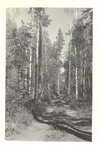“…elements of undiscovered beauty…” – the Emma Lake Art Camp
Surely one of the more remarkable innovations during the Depression years was the formation of an art camp in the northern half of the province. The site was 220 kilometres north of the University’s Saskatoon campus; and was the first outdoor school of art for university credit in Canada.
The decision to establish an art camp at the height of the Depression has been cited as evidence of the ‘resilency’ and the ‘astonishing ebullience of the West.’ It should more properly be seen as evidence of the extraordinary vision of Gus Kenderdine and Walter Murray.
Murray had hired Kenderdine in 1923 as the first “artist-in-residence” at a university in Canada; and in 1927 appointed him to the faculty.
As recounted later by the Kenderdine family, during the Depression “a dreary atmosphere of Russian thistle dust, grasshoppers and caterpillars, had settled like a fog on the spirits of the people…”. The family had “already spent several delightful summers at the Emma Lakes…all so clean and fresh and beautiful…a haven of rest.…oh how we wished that the people from the prairies could share the peace and quiet of the north.”
One day, while exploring they came across “the ideal spot:”on the shores of Emma Lake, an area encompassing pre-Cambrian shield, parkland, and prairie, “a place which more than any other in all this vast province epitomizes Saskatchewan.”
The art school was immediately successful. In its first year, thirty students from across the province attended: 14 paid the $25 tuition-and-recreation fee for the full six-week credit course; the remaining non-credit students stayed for short courses of three to four weeks duration.
The students created a scrapbook to document their experience. “By recording the seemingly unimportant – the local, the intimate, the humorous, we hope to recall, or to convey, that greater body of experience which was rich, deep and significant.”
Emma Lake became significant in many ways. It is difficult to name a prominent Saskatchewan artist who has not been a participant. The early workshops emphasized methods of teaching art in schools; for participants such as Ruth Pawson and McGregor Hone, who eventually became teachers, the impact of ideas from Emma Lake workshops on generations of school children is incalculable.







